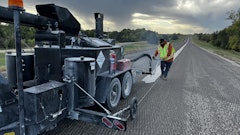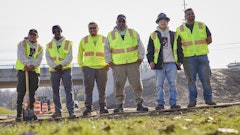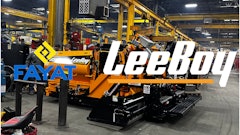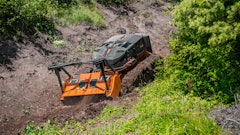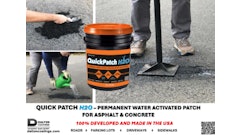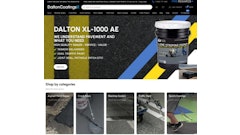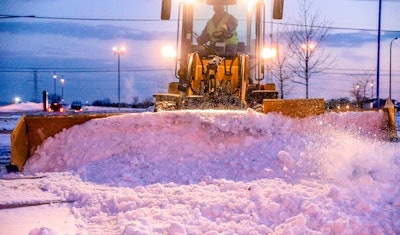
If there is snow in your area, you can bet that you have an off-season that runs from at least December through March, and possibly longer. A particularly wet spring can extend it several weeks longer. Regardless, that is at least a third of the year where equipment and employees are idle, a sizable chunk of time to be sitting without work.
When you consider what you need to start a snow removal business, many of the pieces are already in place. Existing wheel loaders, tractors, excavators, backhoes, skid steers and track machines may all be fitted with snow pushers and plows. You already have trained and reliable operators, which are difficult to come by these days. And finally, you may have an established commercial customer base that you can easily turn into snow removal clients.
Loan payments and equipment depreciation take place regardless of whether equipment is utilized or not, which is even more reason you want to use it all year round. If you are currently renting or leasing equipment because of your seasonality, you will find that your enhanced utilization gives you the ability to negotiate better purchase or financing terms.
In addition to improving equipment utilization in the off season, consider employee retention following seasonal layoffs. Many companies permanently lose good workers, as some may seek out new, year-round jobs and not return when construction kicks back into high gear. In addition, many laid-off employees do not look for temporary jobs but instead collect unemployment. This elevates the company’s unemployment insurance costs, adding major expenses without steady work to offset that cost. By offering the opportunity for year-round employment, a business minimizes the risk of losing quality employees and eliminates the costs associated with hiring and training replacements.
Having year-round services offers the additional opportunity to maximize revenues from existing customers, by becoming more of a “one-stop shop” – a place to go for multiple needs. The new, planned supermarket in town needs to have its parking lot poured, but also have that lot plowed every year thereafter. A diversified construction company can demonstrate the convenience of working with a full-service company by touting the fact it can both pour the concrete and later snowplow the lot. The same is true for landscaping. The client is reassured that you will not only do a nice job on his snow removal but be careful to protect the landscaping you installed over the summer.
Pushers vs. Plows
Successfully entering the snow removal business requires securing the right equipment. These initial costs can seem intimidating to contractors with limited capital, but when the right decisions are made, the actual returns make this a no-brainer. It’s like anything else you need the right tool for the job.
One of the biggest upfront costs for a snowplowing operation is the equipment needed to push the snow. This includes both the actual snow pushers and the machines driving the operation. However, a contractor’s existing machines such as loaders and skid steers can all be repurposed for snow removal, rather than being left idle for the winter season, leaving the pusher as the key piece of equipment to consider.
To draw the distinction between pushers and plows, a plow is an angled blade that guides snow to either side of the driver. A pusher is a containment or box plow with side wings that contains a great quantity of snow which it moves from one end of a parking lot to the other, where it is piled up out of the way. The pusher is the work horse of any commercial snow operation and should be its primary tool.
Selecting the Proper Pusher
To select the proper snow pusher, a contractor must first analyze the existing fleet and select the size pusher that will match well to that machine. Each model of pusher is meant for a particular size of equipment – meaning one designed for a large loader would not work on a small skid steer. Local dealers provide assistance to contractors looking to purchase the right pusher for his or her equipment. Snow pushers come in a variety of sizes, with the smallest measuring 8 ft. to larger units extending well over 20 ft. Contractors can minimize equipment costs by analyzing their existing fleet and then fitting with the appropriate-sized pushers. For example, a small skid steer could be outfitted with an 8-ft. snow pusher and be ready for use. Those with larger equipment in their fleet would want to look at snow pushers in the 16 to 20 ft. range.
No matter how big or small the snow pusher, it is important to purchase one with the greatest potential for return on investment. A high-quality snow pusher will typically pay for itself in the first 30 in. of snowfall – a relatively quick return, considering many areas of the country average this amount in the first few months of the winter season.
When it comes to choosing a high-quality pusher, remember: All snow pushers are not created equal. Many are designed to increase efficiency, cut back on salt usage and reduce potential property damage, and some have unique design features that vastly improve its safety profile. If you want to be an expert in snow removal technology, get prepared to discuss topics such as sectioned moldboards, trip edges, polyurethane mounting blocks, floating side panels and universal slip-hitch mounting systems.
A pusher featuring a sectional moldboard design moves more snow with each pass, and greatly cuts down on plowing and follow up re-plowing time. Each section moves up and down independently, enabling the plow to essentially contour to uneven surfaces and remove snow from dips and depressions in pavement. Because they are can remove more snow and ice with one pass, less salt is required. It is also important to look at the unit’s cutting edge. Rubber and steel trip edges are most common options, with steel cutting edges typically being the best. Steel edges scrape snow and ice down to the pavement and offer cleaner removal with a single pass, further reducing salt needs.
Additionally, it is worth considering a pusher with mechanical side panels. Unlike rigid, fixed side panels, mechanical panels are designed to rotate up and over obstructions like curbs and medians. While this saves greatly on potential damage to the plow, the real benefit comes in preventing expensive damage to the client’s property. Snowplow companies can spend tens of thousands of dollars each year repairing expensive curbing and other such features commonly found in parking lots and on streets.
Some sectional or sectional-like designs use springs as the basis of their up and down movement. The problem with springs is that they are designed to release when encountering a mound of hard-packed snow or ice and so do not perform well in those instances. Also, while they may be able to lift over bumps, they cannot dip into depressions in the pavement. The other negative to springs is that if there is a serious unforeseen impact, springs can deform and the moldboards become damaged, the same as would result in a conventional one-piece design.
A far better design employs the use of flexible polyurethane blocks that add torque to the cutting edge, cleaning up ice and hard-pack as easily as the soft stuff. The blocks flex up and down so the sectioned edges can both avoid obstacles and reach into depressions. They also act as bumpers to protect the equipment and the operator. If the impact is serious enough, the blocks are designed to break before any steel is deformed or the operator hits the windshield, and they can be replaced for under $100.
Evaluate Hitch Options
Finally, the more modern and advanced pushers may also feature newer hitch designs, providing ease of operation and enhanced results. A snow pusher is picked up and set down hundreds of times during a snow event. Typical hitch designs force the operator to manually adjust the plow each time it’s dropped to make It level, making for a very challenging, time-consuming and often frustrating process, especially for inexperienced operators. The other problem Is traction as traditional mounting systems cause the weight of the pusher to lift the machines front tires off the ground. Newer “drop-and-go” hitch designs solve both problems automatically, saving precious time and ensuring a properly placed pusher every time. This is an extremely important but overlooked point until one has actual experience behind a snow pusher. Now, operators who have never plowed a day in their life are soon able to plow as well as experts.
While the pusher is indeed the most significant tool for your business, you need to consider your secondary equipment. Items such as sand and salt spreaders, liquid anti-icing applicators, or snow brooms may be required, depending on the extent of services offered by each individual company. The same principles apply – take the time to research features and benefits. An informed equipment selection is well worth the effort and will pay back dividends.


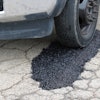

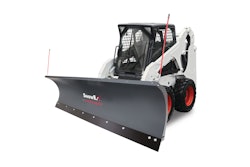
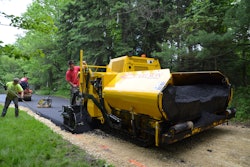
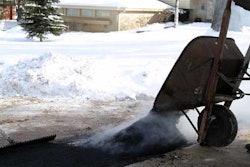

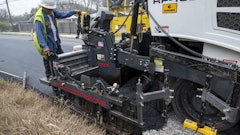

![Lee Boy Facility 2025 17 Use[16]](https://img.forconstructionpros.com/mindful/acbm/workspaces/default/uploads/2025/09/leeboy-facility-2025-17-use16.AbONDzEzbV.jpg?ar=16%3A9&auto=format%2Ccompress&fit=crop&h=135&q=70&w=240)

